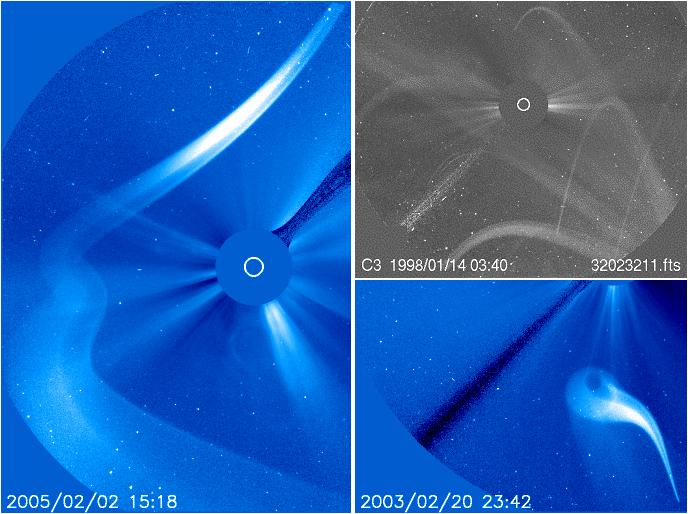
| |
 |
Can Zetas provide answer as to what this is? See the image at 2005/02/02 15:18. Exposure time was 19.1 seconds according to NASA.

Debris from Planet X has been increasingly entering Earth’s atmosphere in the form of meteors or fireballs, once rare but now reported almost weekly in the news, when they are given media attention at all. Exploding with a bang, turning the night sky bright, rattling windows, thudding to Earth next to startled humans. Was this the usual rate just a few years ago? For every fireball not captured by Earth’s atmosphere, there are dozens outside her atmosphere, whizzing about, one of the reasons we have warned that Satellites will not function well in the months leading into the pole shift, and that the Space Station and those riding her are doomed. It is only a matter of time, for man’s technology, aloft. The massive tail of Planet X, being composed primarily of magnetized iron oxide dust, is hosed away from the N. Pole of Planet X, and thus up until now has been pointing toward the Sun, not Earth, as Planet X has been struggling to rise above the Ecliptic and thus must align along the magnetic Flow Lines in the Sun’s southern hemisphere. These flow lines require the N. Pole of Planet X to be pointed toward the Sun, the S. Pole slung outward.
 But what happens when that N. pole slings outward, during the 270° Roll that Planet X will make as it
turns in place and then stands upright, side-by-side with the Sun in a position strong enough to halt the
Earth’s rotation in the days before the pole shift. As the N. pole begins to sling toward the Earth, it hoses
the massive tail and the debris in that tail toward Earth. If fireballs have been an occasional entertainment,
they will soon become a daily affair almost everywhere, and simultaneously no longer in the news as during
a cover-up, such bad news is suppressed. While the SOHO still functions, these fireballs at times make a
graceful pass past the camera, moving in waves. We have, in the early days of ZetaTalk, described why a Wave Action exists for sub-atomic particles on the
move. They are on the move, and while on the move are in a dance with each other as they are in perpetual motion, either moving toward each other due to their
desire to clump, or moving away from each other to equalize crowding. This action, the wave action, and the reasons for it, are not restricted to sub-atomic
particles. The moons of Planet X likewise Dance with each other in what we have described as Moon Swirls. The same mechanism applies, for minor debris
dancing within the fringes of the massive tail of Planet X.
But what happens when that N. pole slings outward, during the 270° Roll that Planet X will make as it
turns in place and then stands upright, side-by-side with the Sun in a position strong enough to halt the
Earth’s rotation in the days before the pole shift. As the N. pole begins to sling toward the Earth, it hoses
the massive tail and the debris in that tail toward Earth. If fireballs have been an occasional entertainment,
they will soon become a daily affair almost everywhere, and simultaneously no longer in the news as during
a cover-up, such bad news is suppressed. While the SOHO still functions, these fireballs at times make a
graceful pass past the camera, moving in waves. We have, in the early days of ZetaTalk, described why a Wave Action exists for sub-atomic particles on the
move. They are on the move, and while on the move are in a dance with each other as they are in perpetual motion, either moving toward each other due to their
desire to clump, or moving away from each other to equalize crowding. This action, the wave action, and the reasons for it, are not restricted to sub-atomic
particles. The moons of Planet X likewise Dance with each other in what we have described as Moon Swirls. The same mechanism applies, for minor debris
dancing within the fringes of the massive tail of Planet X.
- Did this meteor leave a twisting path? Evidently. Meteor trains that twist noticeably are rare - and even more rarely photographed - but have been noted before. The underlying reason for unusual meteor trains is that many meteors are markedly non-spherical in shape and non-uniform in composition. Meteors, usually sand sized grains that originate in comets, will disintegrate as they enter the Earth´s atmosphere. Non-uniform meteors may evaporate more on one side than another. This may cause a rotating meteor to wobble slightly in its path, and also to spray fast moving debris in a nearly spiral path. The fast moving meteor debris ionizes molecules in the Earth´s atmosphere that subsequently glow when they reacquire electrons. Surely no meteor is perfectly uniform and spherical, so that a slight swagger that is below perceptibility is likely typical.
- NASA Explanation
